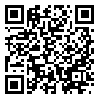Volume 28, Issue 2 (July 2021)
J Birjand Univ Med Sci. 2021, 28(2): 139-146 |
Back to browse issues page
Download citation:
BibTeX | RIS | EndNote | Medlars | ProCite | Reference Manager | RefWorks
Send citation to:



BibTeX | RIS | EndNote | Medlars | ProCite | Reference Manager | RefWorks
Send citation to:
Salari Seddigh S, Daneshdar F, Tavasoli A, Sadeghi M, Hakimizadeh E, Fatemi I. Microscopic examination of the effect of bromelain on the healing of tooth extraction sockets in an animal model. J Birjand Univ Med Sci. 2021; 28 (2) :139-146
URL: http://journal.bums.ac.ir/article-1-2890-en.html
URL: http://journal.bums.ac.ir/article-1-2890-en.html
Somaye Salari Seddigh1  , Fateme Daneshdar2
, Fateme Daneshdar2  , Alireza Tavasoli3
, Alireza Tavasoli3  , Mostafa Sadeghi4
, Mostafa Sadeghi4  , Elham Hakimizadeh5
, Elham Hakimizadeh5  , Iman Fatemi *
, Iman Fatemi *  6
6
 , Fateme Daneshdar2
, Fateme Daneshdar2  , Alireza Tavasoli3
, Alireza Tavasoli3  , Mostafa Sadeghi4
, Mostafa Sadeghi4  , Elham Hakimizadeh5
, Elham Hakimizadeh5  , Iman Fatemi *
, Iman Fatemi *  6
6
1- Department of Periodontology, School of Dentistry, Rafsanjan University of Medical Sciences, Rafsanjan, Iran
2- Dental Student, Student Research Committee, School of Dentistry, Rafsanjan University of Medical Sciences, Rafsanjan, Iran
3- Department of Pathology, School of Medicine, Fasa University of Medical Sciences, Fasa, Iran
4- Department of Restorative Dentistry, School of Dentistry, Rafsanjan University of Medical Sciences, Rafsanjan, Iran
5- Physiology-Pharmacology Research Center, Research Institute of Basic Medical Sciences, Rafsanjan University of Medical Sciences, Rafsanjan, Iran
6- Research Centre of Tropical and Infectious Diseases, Kerman University of Medical Sciences, Kerman, Iran , imanfatemi@gmail.com
2- Dental Student, Student Research Committee, School of Dentistry, Rafsanjan University of Medical Sciences, Rafsanjan, Iran
3- Department of Pathology, School of Medicine, Fasa University of Medical Sciences, Fasa, Iran
4- Department of Restorative Dentistry, School of Dentistry, Rafsanjan University of Medical Sciences, Rafsanjan, Iran
5- Physiology-Pharmacology Research Center, Research Institute of Basic Medical Sciences, Rafsanjan University of Medical Sciences, Rafsanjan, Iran
6- Research Centre of Tropical and Infectious Diseases, Kerman University of Medical Sciences, Kerman, Iran , imanfatemi@gmail.com
Abstract: (1611 Views)
Background and Aims: Bromelain is a substance derived from pineapple and has antioxidant, anti-inflammatory, and analgesic effects. This study aimed to investigate the effect of bromelain on the healing of tooth extraction sockets in an animal model.
Materials and Methods: This experimental study was performed on 24 male rats. After anesthesia, the first maxillary molar tooth was extracted with minimal damage using a hemostat. The rats were randomly divided into two groups, namely control and bromelain. In the bromelain group, the rats were orally administered by gavage with a 500 mg dose of bromelain that was dissolved in water twice a day for 2 days, while the control group received no medications. On the 3rd and 10th days after the surgery, 6 rats were killed per group each day. Afterward, the maxillae of rats were removed and slides were prepared from their dental sockets. The slides were examined by light microscope for histopathological variables (mean of macrophages, fibroblasts, lymphocytes, neutrophils; granulation tissue extent and angiogenesis and bone cells).
Results: The results showed that the angiogenesis and granulation tissue extent increased significantly in the bromelain group, compared to the control group, on the 3rd day (P<0.05). Also, bromelain administration significantly increase the the number of fibroblasts (P<0.01), granulation tissue extent (P<0.05) and angiogenesis (P<0.05) in 3rd day of the experiment in comparison with the 10th day.
Conclusion: The results of the present study showed that bromelain accelerates the process of wound healing after tooth extraction.
Materials and Methods: This experimental study was performed on 24 male rats. After anesthesia, the first maxillary molar tooth was extracted with minimal damage using a hemostat. The rats were randomly divided into two groups, namely control and bromelain. In the bromelain group, the rats were orally administered by gavage with a 500 mg dose of bromelain that was dissolved in water twice a day for 2 days, while the control group received no medications. On the 3rd and 10th days after the surgery, 6 rats were killed per group each day. Afterward, the maxillae of rats were removed and slides were prepared from their dental sockets. The slides were examined by light microscope for histopathological variables (mean of macrophages, fibroblasts, lymphocytes, neutrophils; granulation tissue extent and angiogenesis and bone cells).
Results: The results showed that the angiogenesis and granulation tissue extent increased significantly in the bromelain group, compared to the control group, on the 3rd day (P<0.05). Also, bromelain administration significantly increase the the number of fibroblasts (P<0.01), granulation tissue extent (P<0.05) and angiogenesis (P<0.05) in 3rd day of the experiment in comparison with the 10th day.
Conclusion: The results of the present study showed that bromelain accelerates the process of wound healing after tooth extraction.
Type of Study: Original Article |
Subject:
Oral and Maxillofacial Diseases
Received: 2020/07/22 | Accepted: 2021/03/8 | ePublished ahead of print: 2021/06/19 | ePublished: 2021/06/20
Received: 2020/07/22 | Accepted: 2021/03/8 | ePublished ahead of print: 2021/06/19 | ePublished: 2021/06/20
Send email to the article author
| Rights and permissions | |
 |
This work is licensed under a Creative Commons Attribution-NonCommercial 4.0 International License. |





